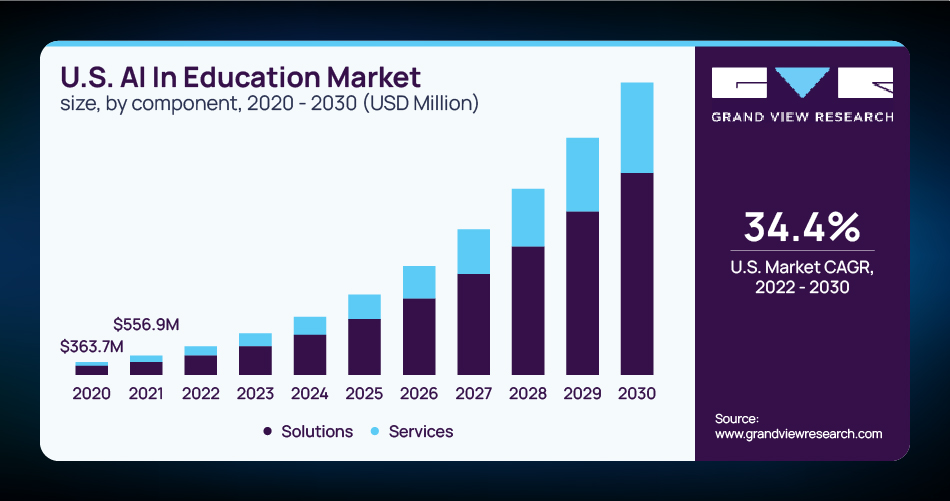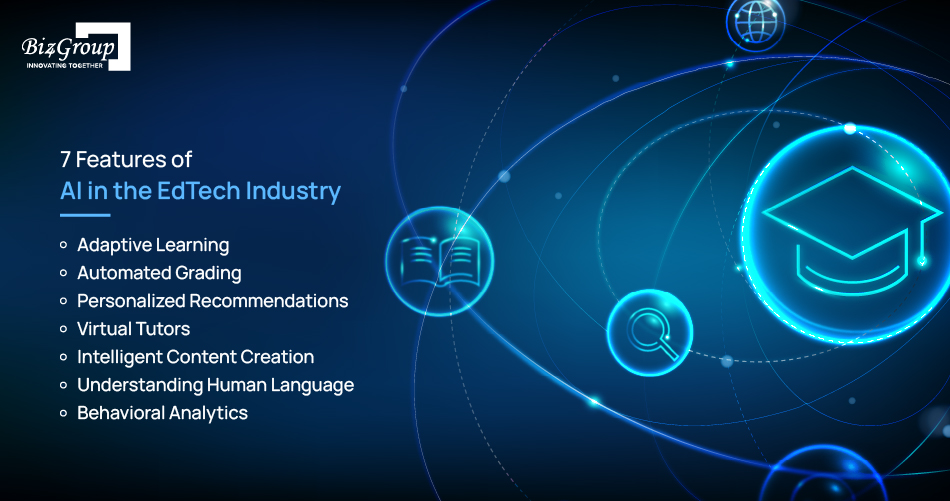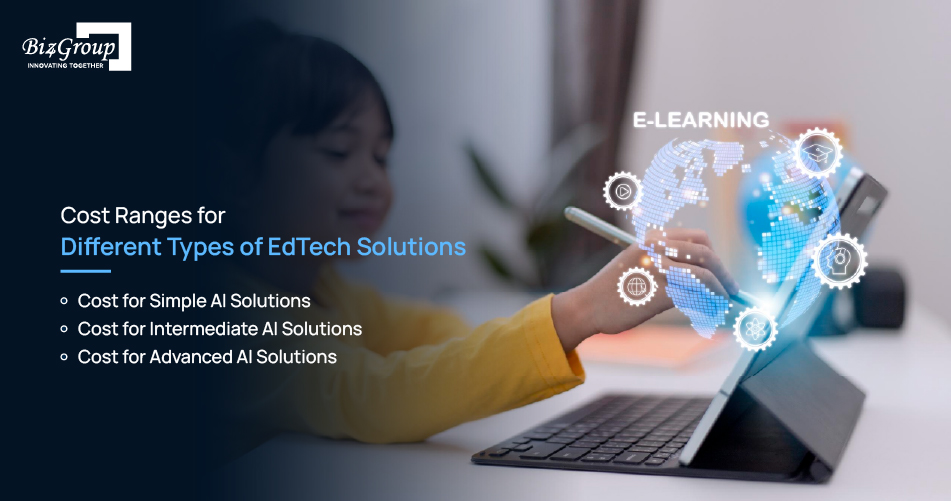Basic AI Chatbot Pricing: A simple chatbot that can answer questions about a product or service might cost around $10,000 to develop.
Read More
Artificial Intelligence (AI) has made tremendous shifts within the Education and Technology (EdTech) area. AI solutions for EdTech provide a wide scope of functionalities that improve efficiency, increase the learning experience, and create different learning programs. However, you need to account for the expenses for the AI initiatives in EdTech which might include chatbot development services as well.
The costs of AI solutions for EdTech critically increase due to several factors, namely the complexity of the project and the development team’s location. In this article, we will explore these critical factors, allowing us insights into higher cost and how to manage such expenses particularly when building a learning platform.
The EdTech industry has grown drastically over the past couple of years, and this recent spike was due to the Coronavirus disease that necessitated the transfer of lecture halls to online.
Generative AI in EdTech sphere has diverse range of applications. It applies to corporate training, language learning applications, and lifelong learning for educational platforms. AI Development Services facilitate this wide application, proving to be a steppingstone to more trade across the EdTech market—the primary area where people invest and innovate.
Also Read: Chatbot in Education Industry: Applications, Use Cases, Benefits, and Development Cost
The AI based education market size was valued at USD 1. $ 82 billion in 2021 and this market is expected to grow with a CAGR of 36%. by adopting these measures remain below or at the levels seen in 2022 to 2030. ( Source )
In fact, 51% of the faculty in the U. S. are more confident about online education than they were before the outbreak, this has been identified in the survey conducted by the University Professional and Continuing Education Association in 2021.
 (Source)
(Source)
To understand the cost of developing AI solutions for EdTech, it's essential to examine the various components that contribute to the overall budget. These components range from the initial planning phase to long-term maintenance and support.
There are various development stages of AI solutions for Edtech businesses. Let’s explore them:
The process of planning comprises the stages of identifying the project parameters, recognizing the users of the project, and stating the main characteristics. The expenditures produced in this stage of development are largely determined by the complexity of the AI solution and the amount of thoroughness in planning. Generative AI development company also conducts market research for a successful alignment with industry trends and the needs of the users.
The user interface (UI) and user experience (UX) constitute a cornerstone for AI and EdTech solutions. A good app design is crucial to the involvement and satisfaction of users but takes investment in expert developers. The cost of design is variable since the design complexity, the need for custom graphics, and the entire app UI design are considered, and this is where eLearning app development services add value by offering customized design solutions.
Coding the app is the most resource-intensive stage. This phase includes front-end and back-end development, where the choice between native and hybrid development affects costs. Native development for specific platforms (iOS or Android) can be more expensive, while hybrid development, which uses shared code across platforms, may offer cost savings. The complexity of AI features, such as machine learning or natural language processing, also plays a role in determining development costs.
The Complexity of the AI, being a factor of cost, adds to the cost. AI capabilities with machine learning models, natural language processing, and adaptability learning algorithms are too complicated and need to be prepared by specialists with considerable development time. The more difficult the AI features implementation, the higher the cost. In addition to this, including AI capabilities which are already present in EdTech platforms may lead to more development work and customization which might hike the cost of implementation.
Where your developers are located may have a great effect on the prices. Regionally, development charges differ, and mostly, developers in North America are paid more than their counterparts in other places. Outsourcing development procurement in low-salary locations can be successful in reducing expenses, but the management should remain careful to meet quality and communication continuity.

The AI solution development for EdTech needs to be innovative and requires unique skills and know-how. As AI continues to get more complex, more developers will require that are well-trained in software development, data science, and artificial intelligence. The level of income that you and your doctor get will determine the final amount. Even though skilled staff require spending, they enable the development of high-quality AI based on a structured procedure.
Integrating other services or platforms like this will increase the cost. For example, if the EdTech solution depends on integrating eLearning management systems, external databases, or other educational applications, more development work might be required. Many deals may be costlier because of the integrations’ complexity and licensing fees.
Furthermore, during the test phase, Custom EdTech development company conducts rigorous testing to ensure stability, functionality, and security. Testing deals with detecting and rectifying bugs, whereas maintenance relates to providing all software updates, security patches, and ongoing functionalities. This phase oftentimes represents 20% - 50% of the initial development budget.
| Country | Cost of AI Development in EdTech | Average Hourly Rate |
|---|---|---|
| United States | $100,000 - $500,000 | $120 - $200 |
| Canada | $40,000 - $250,000 | $50 - $120 |
| United Kingdom | $70,000 - $350,000 | $70 - $110 |
| Germany | $65,000 - $300,000 | $60 - $105 |
| India | $20,000 - $150,000 | $20 - $50 |
| China | $25,000 - $200,000 | $25 - $60 |
| Brazil | $30,000 - $180,000 | $30 - $70 |
| Australia | $75,000 - $350,000 | $60 - $120 |
AI in education can help in enhancing learning experiences and streamline educational processes. Here are some key AI features commonly found in EdTech solutions:

Adaptive learning utilizes AI to provide individualized learning based on students' exact performance. It customizes the learning process, with students offered challenges fitting for them as individuals and at their unique pace.
AI examines multiple-choice tests or even short answers with natural language processing. This function greatly decreases the amount of labor for teachers and delivers instant feedback to the pupils.
AI can suggest individualized materials for students on the topic based on their level of knowledge, learning style, and performance. It makes students more active and helps them to keep up with the coursework throughout. Write your answer in the comment box
AI-powered virtual tutors can provide students with immediate assistance through AI apps. Via these online tutors' students can be provided the opportunity to ask questions, study concepts, and be guided through tough issues in a customized learning approach.
AI in education can create content in the form of quizzes, flashcards, and courses. Through this characteristic, educators can produce interactive teaching materials in a shorter space of time.

Natural language processing (NLP) in computer science allows humans to interact with AI by conveying their intentions in the form of natural language. This function plays well in learning apps and in interactive educational platforms where things are entirely dependent on intuitive actions.
eLearning app development services can make AI to analyze the behavior of students and identify patterns and trends which will be very helpful to teachers to understand the growth of the students and their engagement and performance. Such a data-based framework will offer teachers insights as to how to educate and maximize educational achievements.
Also Read: Top 18 Use Cases of AI Chatbots in Education
The expense of constructing AI solutions for EdTech fluctuates a lot depending on what type and complexity of the task. Some of the similar EdTech applications might have AI integration at the price of tens of thousands of dollars, meanwhile, more complex AI-powered systems with integrated purpose may reach hundreds of thousands.

For the EdTech apps featuring AI with automated grading, and simple recommendations, it can be from $20,000 to $50,000 on average. They are simpler models without complex algorithms that also call for a shorter development time.
Within this price range fall some advanced AI systems with features like adaptive learning or basic machine learning models and they can cost as much as $50,000 and $100,000 respectively. These solutions will largely encompass higher levels of developmental work segments and will also require additional expertise.
AI-based EdTech solutions, with complex machine learning schemes, language representation via NLP, and the processing of mass data sets, cost more than $100,000. This is not only the fact that the implementation of these solutions requires a team of AI experts, but also more time-consuming and thus, demands constant testing and maintenance.
Developing AI solutions for EdTech can be costly, but there are several strategies to help reduce expenses without compromising quality while building a learning platform.

A wise market analysis yields information about the potential market and its expectations. Doing so may help you to reduce the diversions and become more centered on the users’ most important features. Concerning, it can guide you by savvily sorting out the line of the trending industry and user preferences. Furthermore, this will eventually lead to a streamlined and low-cost endeavor.
While creating quality AI-based EdTech options, the primary functions of the product should be of utmost importance. Feature bloat and hiked App costs can be the result of jamming every feature that there is. First, aim at the essential functionalities that are most valuable to your users; the rest can be implemented during the later version.
Open-source technology can substantially lower the cost of licensing, you can save a lot on this option. Open-source AI frameworks and libraries commonly provide robust tools and functions at an unbeatable worth. To this end, it will nurture teamwork and community support, enabling access to help from other units.
Here, the real-world case studies have been provided of the projects built by Biz4Group. Let’s know them in detail:

Biz4Group built AI-powered EdTech for one of its clients. It combines AI techniques that facilitate dynamic and interactive learning. The product ‘ AI-based student evaluation platform ’ created to streamline the evaluation of teachers and facilitate cooperation among the teaching staff.
AI-driven automated evaluations, NLP, and adaptive learning comprise the three most prominent characteristics introducing the personalized learning experience for the students and easing the workflow of educators.
The platform applies AI-based personalized learning paths; as a result, content is tailored to individual students, which, in turn, increases student motivation and understanding. Besides, the AI's tools help get clearer dialogues between teachers and students leading to building a healthier school culture.
With AI automation and predictive analytics used in this product, the product immensely decreases costs associated with teacher training and recruitment. Grading takes place automatically with AI-based goal setting, making the evaluation process less time-consuming.
Educators get a deeper insight into the student's work, and the students can easily monitor and measure their progress. With AI-powered digital training modules, we are one step towards moving away from face-to-face sessions, thus significantly reducing the cost by providing an alternative.
The platform's AI-powered education system has resulted in the achievement of better outcomes, optimization of clarity, and considerable cost savings, testifying to the transformative value of AI in EdTech.

With our AI-driven eLearning project, we revolutionize the education process using this innovative AI-based learning app.
This app uses AI-driven adaptive learning that allows for suitable personalized learning experiences due to its content being based on student performance. This way the evaluation process is moving smoothly with an automatic grading function, that eases up the workload for educators, and AI-driven intelligent content generation helps to create automatically quizzes, flashcards, and study guides.
AI-modeled virtual tutors give students instant support and lead to sustaining a more active and appealing classroom. NLP (natural language processing) functionalities provide AI’s ability to comprehend, and then consequently respond to user queries, subsequently establishing a partnership experience.
The design process was built around a focus on the user's convenience and a completely AI-integrated system. AI-based adaptive learning system was responsible for better results among students, while automated grading and AI-assisted virtual tutors practically solved all educators’ administrative tasks as students engage with the app, the behavioral analytics track their progress, giving meaningful information around student patterns of learning as well as outcomes.
AI-driven web applications have opened new doors to personalized and effective learning, including in remote learning, and have had a considerable impact on both tutor and learner’s experience. Thus, utilizing AI, our project brings generations of students' transformative educational tool that improves studying and eases the standards of education.

The development of AI solutions for EdTech is an enormous investment of resources, but if some obvious benefits can be derived from it, then it will be worth it. AI in education will not only improve learning, but it may also give learners opportunities for highly personalized studying and automation, as well as novel teaching techniques. Knowing the underlying elements of the expenditures and adopting cost-effective techniques will allow you to make a successful and economical AI solution for the education technology industry.
A project is very likely to be successful in the case of planning carefully, giving priority to the crucial parts under test and quality testing and maintenance. Whether you are making a simple online learning app or a complex solution using AI, it will be useful to understand the various cost components and to build your business strategy so you can make good decisions about how to manage your budget and deliver a successful product.
The primary cost factors include the complexity of the AI features, the geographic location of the development team, the level of expertise required, design and development stages, third-party integrations, and ongoing testing and maintenance. Each of these factors can significantly influence the overall cost of the project.
The timeline for developing AI solutions for EdTech depends on the project's complexity. Simple AI-based EdTech apps may take a few months, while more complex solutions with advanced AI features can take six months to over a year. Factors like design, development, testing, and deployment stages also play a role in the timeline.
Essential AI features for EdTech solutions include adaptive learning, automated grading, personalized recommendations, virtual tutors, intelligent content creation, natural language processing (NLP), and behavioral analytics. These features improve the learning experience and streamline educational processes.
IN YOUR BUSINESS FOR FREE
Our website require some cookies to function properly. Read our privacy policy to know more.